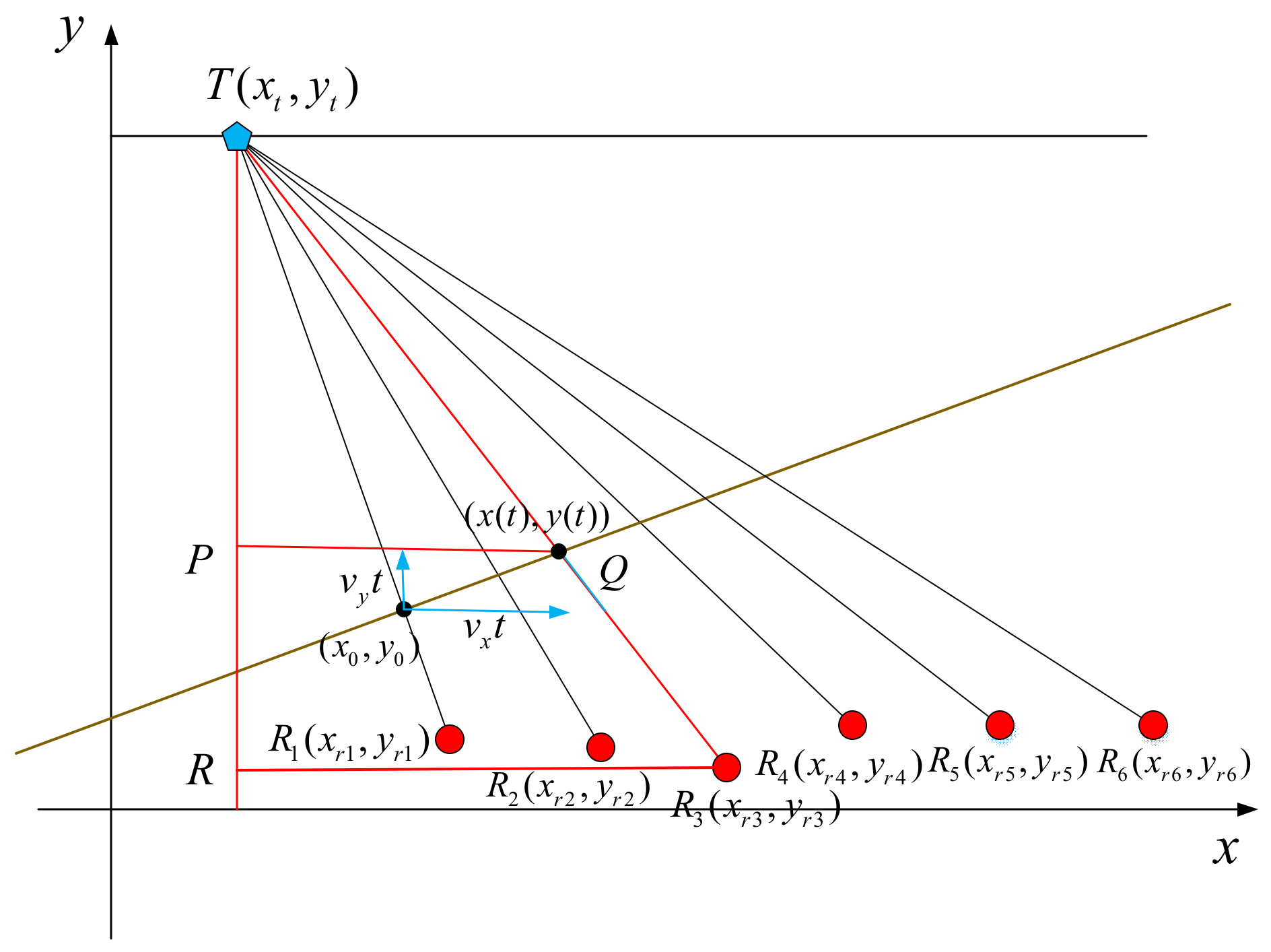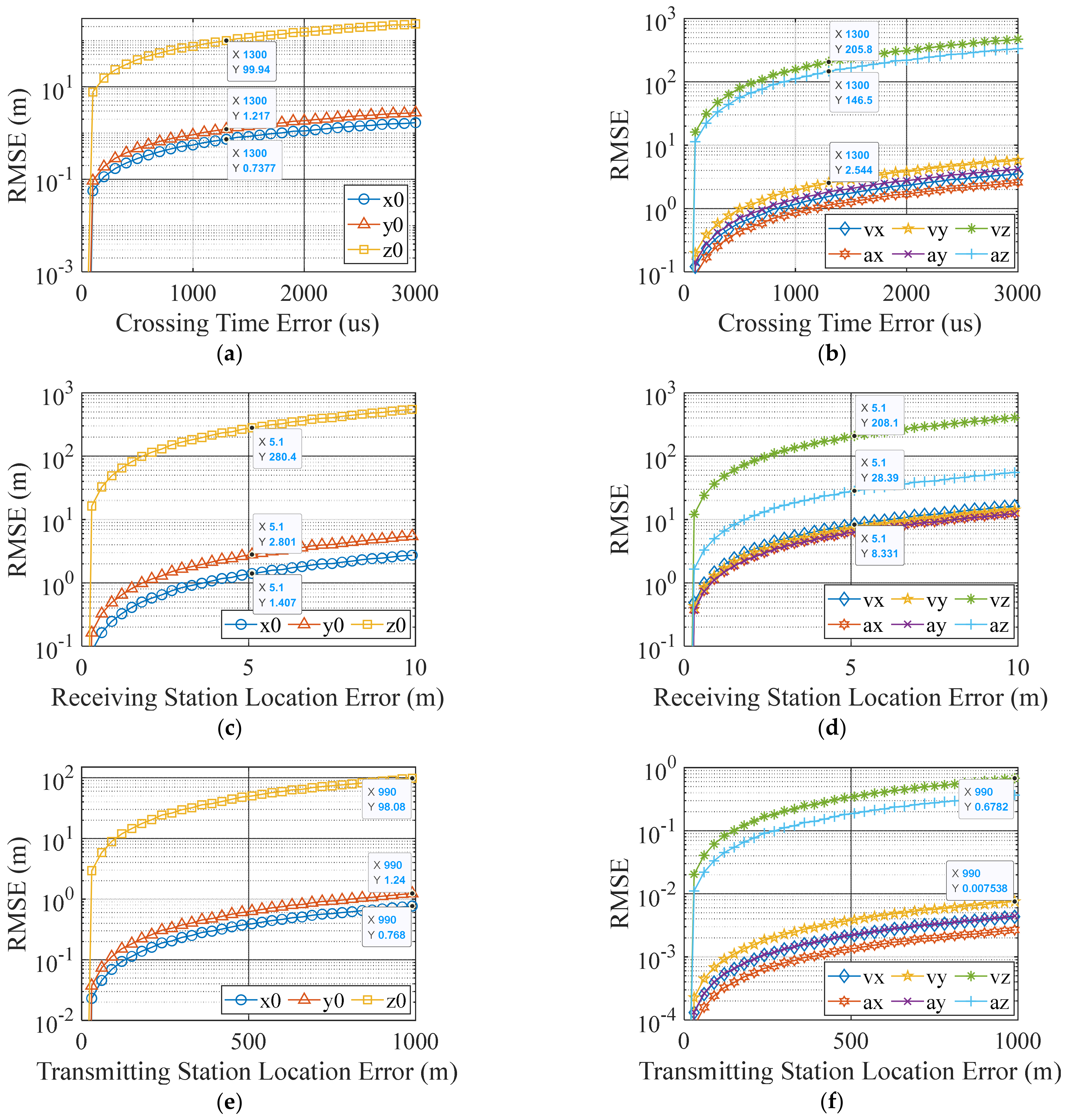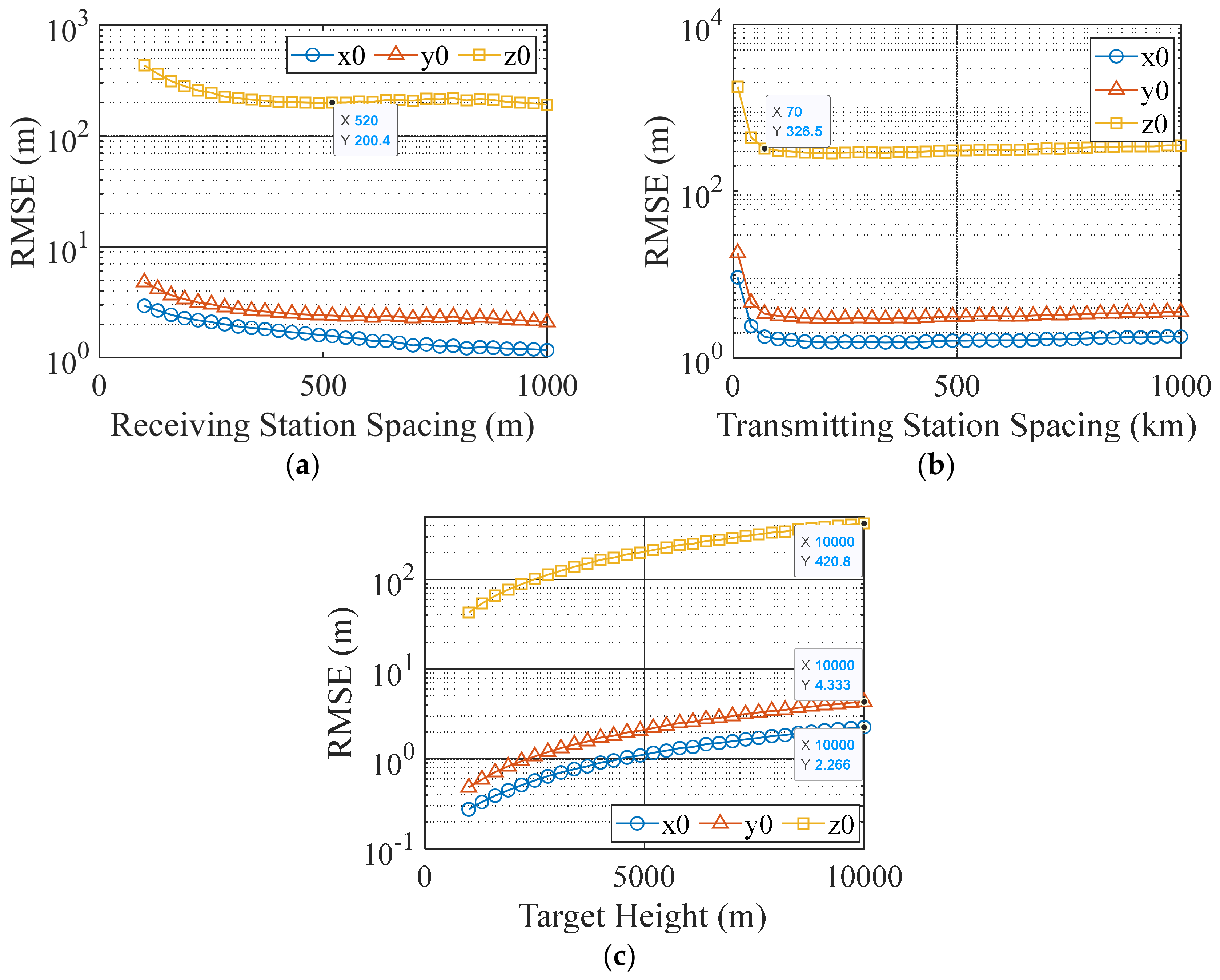Parameter Estimation for Uniformly Accelerating Moving Target in the Forward Scatter Radar Network
Abstract
1. Introduction
2. Observation Model in FSR Network
- (1)
- Satellite navigation signals exist widely, and any point on Earth is illuminated typically by 20–30 satellites simultaneously from different angles;
- (2)
- Satellite navigation signals have high time-frequency synchronization accuracy;
- (3)
- There is no need to make a single passive antenna very large, so it is simple and easy to deploy;
- (4)
- Only the height information needs to be detected, which alleviates the problem of long-distance detection.

3. Proposed Parameter Estimation Method
4. Simulation Verification and Error Analysis
- A.
- Influence of measurement error on estimation accuracy
- B.
- Influence of system structure on estimation accuracy
- C.
- Influence of target motion on estimation accuracy
- (1)
- The location of a moving target with uniform acceleration can be estimated only using the multiple crossing times in a FSR network. Under the condition of existing systematic error, the RMSE of positioning is less than 100 m.
- (2)
- The system structure has an impact on target positioning and motion parameter estimation. It is better to set the receiver spacing to about 500 m and choose the transmitters with good signal quality and large spacings.
- (3)
- Target velocity and acceleration have an impact on target positioning and motion parameter estimation. A high velocity leads to a shorter time for the target to continuously cross multiple baselines and a higher accuracy of target position estimation, while the impact of acceleration can be ignored.
- (4)
- The velocity and acceleration estimate can be referenced when the systematic error is small. However, it is necessary to use position tracking filtering to obtain higher accuracy when the error is large.
5. Conclusions
Author Contributions
Funding
Data Availability Statement
Conflicts of Interest
Appendix A

References
- Hamdollahzadeh, M.; Amiri, R.; Behnia, F. Moving Target Localization in Bistatic Forward Scatter Radars: Performance Study and Efficient Estimators. IEEE Trans. Aerosp. Electron. Syst. 2019, 56, 1582–1594. [Google Scholar] [CrossRef]
- Gao, C.; Yang, D.; Wang, B.; Zhu, Y. Target moving trajectory estimation by multiple receivers based on GPS forward scattering radar. J. Eng. 2019, 2019, 7755–7760. [Google Scholar] [CrossRef]
- Koch, V.; Westphal, R. New approach to a multistatic passive radar sensor for air/space defense. IEEE Aerosp. Electron. Syst. Mag. 1995, 10, 24–32. [Google Scholar] [CrossRef]
- Clemente, C.; Soraghan, J.J. GNSS-Based Passive Bistatic Radar for Micro-Doppler Analysis of Helicopter Rotor Blades. IEEE Trans. Aerosp. Electron. Syst. 2014, 50, 491–500. [Google Scholar] [CrossRef]
- Ma, H.; Antoniou, M.; Stove, A.G.; Winkel, J.; Cherniakov, M. Maritime Moving Target Localization Using Passive GNSS-Based Multistatic Radar. IEEE Trans. Geosci. Remote Sens. 2018, 56, 4808–4819. [Google Scholar] [CrossRef]
- Antoniou, M.; Stove, A.; Tzagkas, D.; Cherniakov, M.; Ma, H. Marine Target Localization with Passive GNSS-Based Multistatic Radar: Experimental Results. In Proceedings of the 2018 International Conference on Radar (RADAR), Brisbane, Australia, 27–31 August 2018; pp. 1–5. [Google Scholar]
- Ma, H.; Antoniou, M.; Pastina, D.; Santi, F.; Pieralice, F.; Bucciarelli, M.; Cherniakov, M. Maritime Moving Target Indication Using Passive GNSS-Based Bistatic Radar. IEEE Trans. Aerosp. Electron. Syst. 2018, 54, 115–130. [Google Scholar] [CrossRef]
- Santi, F.; Pieralice, F.; Pastina, D. Joint Detection and Localization of Vessels at Sea With a GNSS-Based Multistatic Radar. IEEE Trans. Geosci. Remote Sens. 2019, 57, 5894–5913. [Google Scholar] [CrossRef]
- Santi, F.; Pastina, D.; Bucciarelli, M. Experimental Demonstration of Ship Target Detection in GNSS-Based Passive Radar Combining Target Motion Compensation and Track-before-Detect Strategies. Sensors 2020, 20, 599. [Google Scholar] [CrossRef] [PubMed]
- Gomez-Del-Hoyo, P.; Jarabo-Amores, M.-P.; Mata-Moya, D.; Del-Rey-Maestre, N.; Rosado-Sanz, J. First Approach on Ground Target Detection with GPS based Passive Radar: Experimental Results. In Proceedings of the 2019 Signal Processing Symposium (SPSympo), Krakow, Poland, 17–19 September 2019; pp. 71–75. [Google Scholar]
- Hu, C.; Liu, C.; Wang, R.; Chen, L.; Wang, L. Detection and SISAR Imaging of Aircrafts Using GNSS Forward Scatter Radar: Signal Modeling and Experimental Validation. IEEE Trans. Aerosp. Electron. Syst. 2017, 53, 2077–2093. [Google Scholar] [CrossRef]
- Hu, C.; Liu, C.; Zeng, T. Bistatic forward scattering radar detection and imaging. J. Radars 2016, 5, 229–243. (In Chinese) [Google Scholar]
- Zeng, T.; Hu, C.; Cherniakov, M.; Zhuo, C.; Mao, C. Joint parameter estimation and Cramer-Rao bound analysis in ground-based forward scatter radar. EURASIP J. Adv. Signal Process. 2012, 2012, 80. [Google Scholar] [CrossRef][Green Version]
- Gashinova, M.; Daniel, L.; Sizov, V.; Hoare, E.; Cherniakov, M. Phenomenology of Doppler forward scatter radar for surface targets observation. IET Radar Sonar Navig. 2013, 7, 422–432. [Google Scholar] [CrossRef]
- Contu, M.; De Luca, A.; Hristov, S.; Daniel, L.; Stove, A.; Gashinova, M.; Cherniakov, M.; Pastina, D.; Lombardo, P.; Baruzzi, A.; et al. Passive Multifrequency Forward-Scatter Radar Measurements of Airborne Targets Using Broadcasting Signals. IEEE Trans. Aerosp. Electron. Syst. 2017, 53, 1067–1087. [Google Scholar] [CrossRef]
- Daud, N.A.M.; Rashid, N.E.A.; Othman, K.A.; Ahmad, N. Analysis on Radar Cross Section of different target specifications for Forward Scatter Radar (FSR). In Proceedings of the 2014 Fourth International Conference on Digital Information and Communication Technology and its Applications (DICTAP), Bangkok, Thailand, 6–8 May 2014; pp. 353–356. [Google Scholar]
- Blyakhman, A.; Burov, V.; Myakinkov, A.; Ryndyk, A. Detection of unmanned aerial vehicles via multi-static forward scattering radar with airborne transmit positions. In Proceedings of the 2014 International Radar Conference, Lille, France, 13–17 October 2014; pp. 1–5. [Google Scholar]
- Musa, S.A.; Rsa, R.A.; Sali, A.; Isma’Il, A.; Rashid, N.E.A. DVBS based Forward Scattering Radar for Drone Detection. In Proceedings of the 2019 20th International Radar Symposium (IRS), Ulm, Germany, 26–28 June 2019; pp. 1–8. [Google Scholar]
- Radmard, M.; Bayat, S.; Farina, A.; Hajsadeghian, S.; Nayebi, M.M. Satellite-based forward scatter passive radar. In Proceedings of the 2016 17th International Radar Symposium (IRS), Krakow, Poland, 10–12 May 2016; pp. 1–4. [Google Scholar]
- Hu, C.; Sizov, V.; Antoniou, M.; Gashinova, M.; Cherniakov, M. Optimal Signal Processing in Ground-Based Forward Scatter Micro Radars. IEEE Trans. Aerosp. Electron. Syst. 2012, 48, 3006–3026. [Google Scholar] [CrossRef]
- Hu, C.; Zeng, T.; Zhou, C. Accurate three-dimensional tracking method in bistatic forward scatter radar. EURASIP J. Adv. Signal Process. 2013, 2013, 66. [Google Scholar] [CrossRef][Green Version]
- Hu, C.; Wang, L.; Liu, C. SISAR imaging method based on GNSS signal: Theory and experimental results. In Proceedings of the 2016 CIE International Conference on Radar (RADAR), Guangzhou, China, 10–13 October 2016; pp. 1–5. [Google Scholar]
- Pastina, D.; Contu, M.; Lombardo, P.; Gashinova, M.; De Luca, A.; Daniel, L.; Cherniakov, M. Target motion estimation via multi-node forward scatter radar system. IET Radar Sonar Navig. 2016, 10, 3–14. [Google Scholar] [CrossRef]
- De Luca, A.; Contu, M.; Hristov, S.; Daniel, L.; Gashinova, M.; Cherniakov, M. FSR velocity estimation using spectrogram. In Proceedings of the 2016 17th International Radar Symposium (IRS), Krakow, Poland, 10–12 May 2016; pp. 1–5. [Google Scholar]
- Liu, C.; Hu, C.; Wang, R.; Nie, X.; Liu, F. GNSS forward scatter radar detection: Signal processing and experiment. In Proceedings of the 2017 18th International Radar Symposium (IRS), Prague, Czech Republic, 28–30 June 2017; pp. 1–9. [Google Scholar]
- Gashinova, M.; Daniel, L.; Cherniakov, M.; Lombardo, P.; Pastina, D.; De Luca, A. Multistatic Forward Scatter Radar for accurate motion parameters estimation of low-observable targets. In Proceedings of the 2014 International Radar Conference, Lille, France, 13–17 October 2014; pp. 1–4. [Google Scholar]





| Number | Country | Object | Detection Method | Receive Gain (dB) | Accumulation Time | Detection Range |
|---|---|---|---|---|---|---|
| 1 | Germany [3] | Space Station | Signal disturbance Analysis | −5~−3 | 20 ms | 400 km |
| 2 | Britain [4] | Merchant ship (180 × 25 m) | Long integration time MTI processing | 15 | 50 s | 3 km |
| 3 | Britain [7] | Helicopter | Micro-Doppler signature Analysis | 25 (with LNA) | 21 ms | 2.4 km |
| 4 | Italy [8,9] | Merchant ship (150 × 23 m) | Long integration time; Track-before-detect | 15 | 10 s | 1.8 km |
| 5 | Spain [10] | Car | Coherent integration of consecutive CAFs | 35 (with LNA) | 1s | 60 m |
| 6 | China [11] | A321/A330 | SISAR Imaging | 4 | 20 ms | 1 km |
| Error Source | Main Factor | Standard Deviation |
|---|---|---|
| Crossing time measurement error | Space noise environment, target crossing inaccurately, RCS fluctuation, system synchronization error, etc. | <1300 µs |
| Receiver station site error | Station position measurement error | 3~5 m |
| Transmitter station site error | Satellite motion, satellite position measurement error | <1000 m |
| Target | Flight trajectory (2D) (m) | Y = 200x + 7000 |
| Velocity (m/s) | 350 | |
| Acceleration (m/s2) | 50 | |
| Receiver | R1 (m) | (0,0,0) |
| R2 (m) | (400,400,10) | |
| R3 (m) | (800,800,−10) | |
| Transmitter | T1 (km) | (100,200,20,200) |
| T2 (km) | (200,300,20,200) | |
| Errors | The standard deviation of crossing time error (us) | 300 |
| The standard deviation of receiver station site error (m) | 5 | |
| The standard deviation of transmitter station site error (m) | 1000 |
Publisher’s Note: MDPI stays neutral with regard to jurisdictional claims in published maps and institutional affiliations. |
© 2022 by the authors. Licensee MDPI, Basel, Switzerland. This article is an open access article distributed under the terms and conditions of the Creative Commons Attribution (CC BY) license (https://creativecommons.org/licenses/by/4.0/).
Share and Cite
Ai, X.; Zheng, Y.; Xu, Z.; Zhao, F. Parameter Estimation for Uniformly Accelerating Moving Target in the Forward Scatter Radar Network. Remote Sens. 2022, 14, 1006. https://doi.org/10.3390/rs14041006
Ai X, Zheng Y, Xu Z, Zhao F. Parameter Estimation for Uniformly Accelerating Moving Target in the Forward Scatter Radar Network. Remote Sensing. 2022; 14(4):1006. https://doi.org/10.3390/rs14041006
Chicago/Turabian StyleAi, Xiaofeng, Yuqing Zheng, Zhiming Xu, and Feng Zhao. 2022. "Parameter Estimation for Uniformly Accelerating Moving Target in the Forward Scatter Radar Network" Remote Sensing 14, no. 4: 1006. https://doi.org/10.3390/rs14041006
APA StyleAi, X., Zheng, Y., Xu, Z., & Zhao, F. (2022). Parameter Estimation for Uniformly Accelerating Moving Target in the Forward Scatter Radar Network. Remote Sensing, 14(4), 1006. https://doi.org/10.3390/rs14041006






